Timeline of the history of the region of Palestine

Satellite image of the Israel region from 2003
This timeline represents major events in the region of Palestine, which at different times during human habitation included a diverse number of people, cultures, religions and nations while being a part of several major empires and an important trade link between Europe and North African coast in the west and Asia and India in the East.
For a more detailed article about the history of region see History of Palestine (region).
This list is incomplete; you can help by expanding it.
Prior to the 2nd millennium BC
- c. 65 to 70 million BC – A Prognathodon died in the Negev region. The complete skull of a marine reptile was discovered in a phosphate mine in the Negev in 1993.[1][2]
- c. 380,000–200,000 BC – The Qesem Cave was occupied by prehistoric humans.[3]
- c. 9000 BC Natufian hunter-gatherer groups form a permanent settlement that would come to be known as Jericho
2nd millennium BC
- c. 1900–1700 BC – The period of the Patriarchs in the region[4]
- c. 1469 BC – In the Battle of Megiddo, Egyptian forces under the command of Pharaoh Thutmose III defeat a large Canaanite coalition under the king of Kadesh.[5][6]
- c. 1275–1225 BC – Moses led the Israelites from ancient Egypt through the wilderness.[4]
- c. 1200 BC – The conquest of Canaan by Joshua.[4]
- c. 1120 BC – The Israelite army led by Barak and Deborah defeat the Canaanite armies led by Sisera at a great battle held at Mount Tabor and near the Kishon River.[7]
- c. 1050 BC – Due to the defeat of the Israelites in a battle, the Philistines capture the Ark of the Covenant. After about seven months the Philistine city leaders decide to return the Ark of the Covenant to the Israelites.[8]
- c. 1026 BC – Saul becomes the first king of the United Kingdom of Israel.[7]
- c. 1004 BC – Ish-bosheth becomes the second king of the United Kingdom of Israel.[7]
- c. 1003 BC –David becomes the third king of the United Kingdom of Israel.[7]
1st millennium BC
10th century BC

Entrance to the First Temple (20th-century painting)
- c. 1000 BC – King David captures Jerusalem and establishes it as the City of David and the capital of the United Kingdom of Israel.[9]
- c. 970 BC – Solomon becomes king of the Israelites.[10]
- c. 965 BC – David, king of the ancient Israelites, died.[11]
- c. 940 BC – The First Temple on Mount Moriah in Jerusalem is completed.

Rehoboam's Kingdom of Judah
- c. 931 BC – Solomon died in Jerusalem, and the Golden Age of Israel ends. As a result the kingdom splits into two kingdoms: Israel (including the cities of Shechem and Samaria) in the north and Judah (containing Jerusalem) in the south led by Rehoboam.
- 925 BC – Sack of Jerusalem (925 BC) - Pharaoh Sheshonk I of the Third Intermediate Period invades Canaan following the Battle of Bitter Lakes. Possibly the same as Shishak, the first Pharaoh mentioned in the Torah who captured and pillaged Jerusalem.
9th century BC
- 853 BC – The Battle of Qarqar in which Jerusalem's forces were likely involved in an indecisive battle against Shalmaneser III of Neo-Assyria (Jehoshaphat King of Judah was allied with Ahab King of the Israel according to the Jewish Bible).[12]
- c. 850 BC – Jerusalem is sacked by Philistines, Arabs and Ethiopians, who looted King Jehoram's house, and carried off all of his family except for his youngest son Jehoahaz.
- c. 830 BC – Hazael of Aram Damascus conquers most of Canaan. According to the Jewish Bible, Jehoash of Judah gave all of Jerusalem's treasures as a tribute, but Hazael proceeded to destroy “all the princes of the people” in the city.
8th century BC
- 786 BC – Jehoash of Israel sacks Jerusalem, destroys the walls and takes Amaziah of Judah prisoner.
- 733 BC – According to the Tanakh, Jerusalem becomes a vassal of the Neo-Assyrian Empire[13] after Ahaz of Judah appeals to Tiglath Pileser III of the Neo-Assyrian Empire to protect the city from Pekah of Israel and Rezin of Aram. Tiglath Pileser III subsequently conquers most of the Eastern Mediterranean. At around this time, the Siege of Gezer (c. 733 BC), 20 miles (32 km) west of Jerusalem, is recorded on a stone relief at the Assyrian royal palace in Nimrud.
- 712 BC – Assyrian Siege of Jerusalem - Jerusalem pays further tribute to the Neo-Assyrian Empire after the Neo-Assyrian King Sennacherib laid siege to the city.
7th century BC
- 626 BC – following the death of the king of Assyria Assurbanipal, Nabopolassar revolts against Assyria and establishes the Neo-Babylonian Empire.
- 609 BC – After the Battle of Megiddo (609 BC) the region becomes part of the Empire of the Twenty-sixth dynasty of Egypt.
- 605 BC – The region of the Kingdom of Israel returns to Babylonian control after the Battle of Carchemish in which Crown Prince Nebuchadnezzar II of Babylon defeated the army of Necho II of Egypt.
6th century BC

The Babylonian captivity (painting by James Tissot from c. 1896 to 1902)
- 16 March 597 BC – Babylonians capture Jerusalem following a siege, replace Jehoiachin with Zedekiah as king.
- 597 BC – Exile of prominent Jews (including Ezekiel) to Babylonia.
- 587 BC – Jerusalem falls to the Babylonians, ending the Kingdom of Judah. The conquerors destroy the Jewish Temple of Jerusalem and exile some of the land's inhabitants.
- 538 BC – After Cyrus the Great conquered the Babylonian Empire a year earlier, he declared that the Israelites are allowed to return to Jerusalem and rebuild the Temple.
- 25 February 516 BC – Construction of the Second Temple is completed.
5th century BC
- 459 BC – The Jewish priest Ezra assembles and leads a band of approximately 5,000 Jews from Babylon to Jerusalem.
- 445 BC – Nehemiah, the Jewish cup-bearer to Artaxerxes I at Susa, is given permission by Artaxerxes to return to Jerusalem as governor of Judea, in order to rebuild parts of it.
- 400 BC – The Torah is canonized.
4th century BC
- 332 BC – Alexander the Great conquered the region from the Persian Empire.
- 301 BC – Ptolemy I Soter conquered the region from the heirs of Alexander the Great.
3rd century BC
- 22 June 217 BC – Egyptian native hoplites under Ptolemy IV crushes the Seleucid army under Antiochus III at Raphia near Gaza. The realization of their military importance leads to demands by native Egyptians for greater privileges and so to the development of racial difficulties which will weaken the Ptolemy dynasty in the future.
- 200 BC – Antiochus III the Great from the Seleucid dynasty conquered the region from the Ptolemaic dynasty.
2nd century BC
- 198 BC – The Battle of Panium is fought between Seleucid forces led by Antiochus III and Ptolemaic forces led by Scopas of Aetolia. The Seleucids win the battle which allows Antiochus III to obtain entire possession of the region of Syria Palaestina and Coele-Syria from King Ptolemy V of Egypt.
- 167–160 BC – Maccabean Revolt: Jewish revolt against the Seleucid Empire.
- 160–63 BC – The independent rule of the Hasmoneans.
1st century BC
Model of the Second Temple at the Israel Museum
.jpg)
Birth of Jesus (painting by Gerard van Honthorst from 1622)
- 76 BC – Hyrcanus II becomes high priest of Jerusalem for first time, on the death of his father, Alexander Jannaeus, until 66 BC.
- 67 BC – Hyrcanus II becomes king of Judea, for first time (until 66 BC), on death of his mother, Salome Alexandra.
- 66 BC – Aristobulus II becomes king and high priest of Judea (until 63 BC).
- 63 BC – Rome sends Pompey the Great and his forces to Judea to intervene in the civil war between the two religious sects who were fighting each other for control over the whole kingdom.
- 63 BC – Pompey the Great conquers Jerusalem during Yom Kippur after another Siege of Jerusalem and as a result brings about the end of the Hasmonean Kingdom and incorporates Judea into the Roman Republic. During the battle over Jerusalem the Roman troops kill about 12,000 Jews including many priests at the temple compound.
- 63 BC – King Judah Aristobulus II is removed from power, while his brother John Hyrcanus II is reappointed king (ethnarch) under Roman suzerainty and high priest.
- 47 BC – Herod is appointed governor of Galilee.[14]
- 40 BC – the Parthians invade Judea, seize Jerusalem and appoint Antigonus II Mattathias King of Judea.
- 37 BC – Herod the Great seizes back power in Judea with the help of the Romans and executes Antigonus II Mattathias.
- 31 BC – The Jordan Rift Valley experiences another powerful earthquake.
- 27 BC – King Herod rebuilds Samaria and calls it "Sebastia".[15]
- 25–13 BC – King Herod builds the coastal city and harbor of Caesarea.[16]
- 23 BC – King Herod builds a palace and fortress called Herodium, about 7.5 miles (12 km) south of Jerusalem.[17]
- 19 BC – King Herod the Great further extends the Temple Mount's natural plateau and rebuilds the temple.[18]
- 4 BC – King Herod's death.[19]
- 7–2 BC – Birth of Jesus.[20]
1st millennium
1st century

The destruction of Jewish Temple (painting by David Roberts from 1850)
- 6 AD – Romans create larger province called Iudaea, which is formed by combining Judea proper with Samaria and Idumea.[21]
- 26–33 AD - Approximate date of the Crucifixion of Jesus
- 66–73 AD – The First Jewish–Roman War occurs, the first uprising of Jews of the Iudaea province against the rule of the Roman Empire. The upraising fails and leads to destruction of the Jewish Temple and the conquest of Masada.
- 70 AD - First Jewish–Roman War: The Roman Empire conquer Jerusalem and destroy the Second Jewish Temple. Jews are banned from their city by the Roman conqueror.
- 73 AD - First Jewish–Roman War: The conquest of Masada by the Roman Empire ends the Jewish Rebellion.
2nd century
- 130 AD – Roman emperor Hadrian builds a Roman city he called "Colonia Aelia Capitolina" on the ruins of Jerusalem.
- 132–135 AD – The Bar Kokhba revolt takes place, the third major rebellion by the Jews of Iudaea Province against the rule of the Roman Empire. After the rebellion failed emperor Hadrian changed the name of the province from Iudaea to "Syria Palaestina" in order to complete the dissociation between the Jewish rebels to the region.
4th century
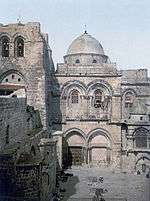
Church of the Holy Sepulchre (photo from 1900)
- 324 – Emperor of the Eastern Roman Empire Constantine the Great, having defeated Emperor Maximian, Caesar of the Western Roman Empire at the Battle of the Milvian Bridge becomes the sole ruler of the re-united Roman Empire with its capital at Byzantium (New Rome) and declares Christianity as the official religion of the empire. Queen Helena, a devout Christian, wife of Eastern Roman Emperor Constantius and mother of Constantine the Great, departs for the Holy Land and begins the construction of churches.
- 326–333 – Concurrent construction of the world's first 4 church buildings under Helena's Tutelage: The Church of the Nativity is built in Bethlehem, marking the site where according to Christian tradition Jesus was born; "Eleona" (Greek: Olive) on the Mount of Olives in Jerusalem also called "Chapel of The Apostles" marking the site where according to Christian tradition Jesus ascended to heaven; The Church of The Holy Cross, later called The Church of the Holy Sepulchre is built in Jerusalem on the hill of Golgotha marking the site where according to Christian tradition Jesus was crucified, buried and resurrected; Mamre, near Hebron.
- 351–352 – Jewish revolt against Gallus: the Jewish community began a rebellion in the region of Palestine against the Caesar of the Byzantine (Eastern Roman) Emperor Constantius Gallus. The revolt was quickly subdued by Gallus' general Ursicinus.
- 362 – Roman emperor Julian the Apostate ordered Alypius of Antioch to rebuild the Jewish Temple.[22]
- 363 – The severe Galilee earthquake of 363 occurred. The earthquake resulted in, among other things, a halt in the construction of the Jewish Temple, mainly because the earthquake ruined the early stages of the construction. Eventually the plan to rebuild the Temple was completely dropped after the death of emperor Julian in June 363.
5th century
- 425 – The Sanhedrin is disbanded by the Byzantine Roman Empire.
6th century
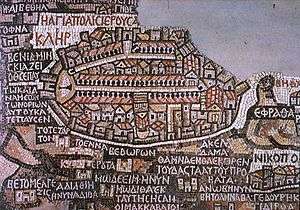
The Madaba Map depiction of 6th-century Jerusalem
7th century
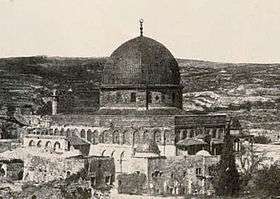
The Dome of the Rock (photograph from 1856)
- 614 – The Persian Empire under general Shahrbaraz captures and sacks Jerusalem; the Church of the Holy Sepulchre is damaged by fire and the True Cross is captured.
- 629 – Byzantine Emperor Heraclius retakes Jerusalem, after the decisive defeat of the Sassanid Empire at the Battle of Nineveh (627). Heraclius personally returns the True Cross to the city.[23]
- 638 – the conquest of Jerusalem by the armies of the Rashidun Caliphate (Islamic Empire) under Caliph Umar Ibn el-Khatab. Jews are permitted to return to the city after 568 years of Roman and Byzantine rule.
- 661 – The beginning of the Umayyad Caliphate rule from Damascus following the assassination of the Caliph Ali ibn Abi Talib.
- 687–691 – the caliph Abd al-Malik ibn Marwan of the Umayyad dynasty establishes the Muslim shrine Dome of the Rock on the Temple Mount in Jerusalem at the site of the First and Second Jewish Temples, a site which according to Muslim tradition was the place where Muhammad ascended to heaven.[24]
8th century

Scythopolis (Beit She'an) was one of the cities destroyed during the earthquake of 749
- 749 – The Seventh Earthquake: Another powerful earthquake is recorded in the Jordan Rift Valley. The cities of Tiberias, Beit She'an, Hippos and Pella were largely destroyed while many other cities throughout the Jordan Rift Valley region were heavily damaged. In addition, the earthquake reportedly claimed tens of thousands of victims.[25][26]
- 750 – The Abbasids overthrew the Umayyad Caliphate.
9th century
- 878 – The Tulunids occupied most of the former Byzantine Diocese of the East, enabling them to defend Egypt against Abbasid attack.
10th century
- 905 – The Abbasids reconquered the region.
- 970 – The Fatimids, a self-proclaimed Shia caliphate, took control and appointed a Jewish governor.
2nd millennium
11th century

Conquest of Jerusalem in 1099 during the First Crusade (painting from the middle ages)
- 18 October 1009 – The Church of the Holy Sepulchre is destroyed by Caliph al-Hakim bi-Amr Allah.
- 1071 – The Seljuk Turks invaded large portions of West Asia, including Asia Minor and the Eastern Mediterranean
- 27 November 1095 – Pope Urban II launches the First Crusade at the Council of Clermont with the principal objective — the Catholic reconquest of the sacred city of Jerusalem and the Holy Land and freeing the Eastern Christians from Islamic rule.
- 1096–1099 – First Crusade and the establishment of the Catholic Kingdom of Jerusalem in Outremer.
- 15 July 1099 – Catholic soldiers under Godfrey of Bouillon, Robert II of Flanders, Raymond IV of Toulouse and Tancred take Jerusalem after a difficult siege, killing nearly every inhabitant.
- 12 August 1099 – The Crusaders defeat the Fatimids at the Battle of Ascalon.
12th century
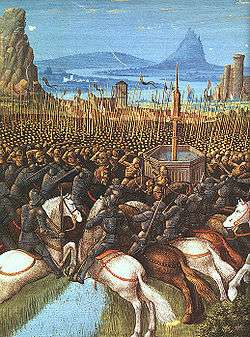
Battle of Cresson (painting from the middle ages)
- 25 November 1177 – Battle of Montgisard: Baldwin IV of Jerusalem and Raynald of Chatillon defeat Saladin.
- 1 May 1187 – Battle of Cresson: Saladin defeats the crusaders.
- 4 July 1187 – Battle of Hattin: Saladin defeats Guy of Lusignan, King of Jerusalem.
- 2 October 1187 – Saladin captured Jerusalem from Crusaders.
- 1189–1192 – Third Crusade led by the armies of Richard the Lionhearted.
- August 1189–July 1191 – The Siege of Acre took place during the Third Crusade.
- 20 August 1191 – Richard the Lionhearted had 2,700 of the Muslim prisoners from the garrison of Acre decapitated.
- 7 September 1191 – Richard I of England defeats Saladin at the Battle of Arsuf during the Third Crusade.
13th century

Siege of Acre (painting by Dominique Papety from 1840)
- 1260 – Battle of Ain Jalut between the Egyptian Mamluks and the Mongols which took place in the Jezreel Valley.
- 1265 – The Mamluk Bahri dynasty of Egypt captures several cities and towns from Crusader states in the Middle East, including the cities of Haifa, Arsuf, and Caesarea Maritima.
- 18 May 1291 – Fall of Acre: Al-Ashraf Khalil of Egypt captures Acre, thus exterminating the Crusader Kingdom of Jerusalem (the final Catholic landholding remaining from the Crusades), and ending the Ninth Crusade and effectively all Crusades, by eliminating the possibility of further attacks on the Holy Land.
16th century
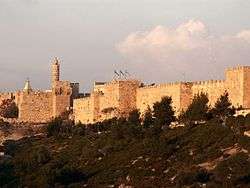
Walls of Jerusalem (photo taken in 2005)
- 1517 – conquest of the Levant by the armies of the Turkish Sultan Selim I.
- 1517 - 1517 Hebron pogrom.
- 1538–1535 – Suleiman the Magnificent restores the Dome of the Rock in Jerusalem and the Jerusalem city walls (which are the current walls of the Old City of Jerusalem).
- 1541 – Ottoman Sultan Suleiman I sealed off the Golden Gate to prevent the Jewish Messiah's entrance.
- 14 January 1546 – A devastating earthquake shook the Jordan Rift Valley region. The epicenter of the earthquake was in the Jordan River in a location between the Dead Sea and the Sea of Galilee. The cities of Jerusalem, Hebron, Nablus, Gaza and Damascus were heavily damaged.
17th century
- 1660 – The towns of Safed and nearby Tiberias, with substantial Jewish communities, were destroyed in the turmoil, following the 1658 death of Mulhim Ma'n,[27] with only Safed being repopulated shortly after the destruction.[28][29] Some sources place the destruction of Safed in 1662.[30]
- 1604 – First Protectorate of missions agreed under the Capitulations of the Ottoman Empire, in which Ahmad I agreed that the subjects of Henry IV of France were free to visit the Holy Places of Jerusalem. French missionaries begin to travel to Jerusalem and other major Ottoman cities.
- 1663-5 – Sabbatai Zevi, founder of the Sabbateans, preaches in Jerusalem before travelling back to his native Smyrna where he proclaimed himself the Messiah
18th century
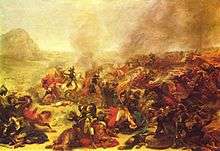
Battle of Nazareth (painting by Antoine-Jean Gros from 1801)
- 1700 – Judah the Pious with 1,000 followers settle in Jerusalem.
- 30 October 1759 – Another devastating earthquake shook the Jordan Rift Valley region. The epicenter of the earthquake was again in the Jordan River, in a location between the Sea of Galilee and the Hula Valley. The cities of Safed, Tiberias, Acre, Sidon were heavily damaged.
- 1798 – Napoleon Bonaparte leads the French Campaign in Egypt and Syria.
- 3–7 March 1799 – Napoleonic Wars: Siege of Jaffa - Napoleon captures the city of Jaffa.
- 20 March–21 May 1799 – Napoleonic Wars: Siege of Acre – An unsuccessful attempt by Napoleon to capture the city of Acre.
- 8 April 1799 – Napoleonic Wars: Battle of Nazareth
- 11 April 1799 – Napoleonic Wars: Battle of Cana
- 16 April 1799 – Napoleonic Wars: The Battle of Mount Tabor – Napoleon drives Ottoman Turks across the River Jordan near Acre.
19th century
- 10 May 1832 – Mohammed Ali leading Egyptian forces, and aided by local Maronites, seize Acre from the Ottoman Empire after a 7-month siege.
- 1834 – 1834 Arab revolt in Israel.
- 1 January 1837 – Galilee earthquake of 1837 - A devastating earthquake that shook the Galilee region, killing thousands of people.[31]
- 15 July 1840 – The Austrian Empire, the United Kingdom of Great Britain and Ireland, the Kingdom of Prussia, and the Russian Empire sign the Convention of London with the ruler of the Ottoman Empire. The signatories offered to Muhammad Ali and his heirs permanent control over Egypt and the Acre Sanjak (roughly what is now Israel), provided that these territories would remain part of the Ottoman Empire and that he agreed within ten days to withdraw from the rest of Syria and returned to Sultan Abdülmecid I the Ottoman fleet which had defected to Alexandria. Muhammad Ali was also to immediately withdraw its forces from Arabia, the Holy Cities, Crete, the district of Adana, and all of the Ottoman Empire.
- 1860 – The first Jewish neighborhood (Mishkenot Sha'ananim) is built outside the walls of the Old City of Jerusalem.[32]
- 1874 – Jerusalem becomes a Mutesarrifiyyet gaining a special administrative status.
- 1882–1903 – The First Aliyah took place in which 25,000-35,000 Jew immigrants immigrated to Ottoman Syria.
- 1887-8 – Ottoman Syria was divided into Jerusalem Sanjak, Nablus Sanjak and Acre Sanjak
- 29–31 August 1897 – The First Zionist Congress is held in Basel, Switzerland, in which the World Zionist Organization was founded and the Basel Declaration was approved which determined that the Zionist movement ultimate aim is to establish and secure under public law a homeland for the Jewish people. It is to be located in the Biblical region daubed variously "The Holy Land" or "Palestine" by the European Christians during the Catholic and later secular Enlightenment.
- 1898 – German Kaiser Wilhelm visits Jerusalem to dedicate the Lutheran Church of the Redeemer. He meets Theodore Herzl outside city walls.
20th century

Ottoman machine gunners during the Second Battle of Gaza, 1917
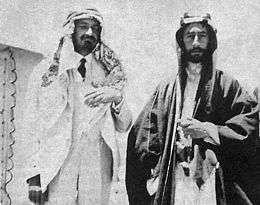
Emir Feisal and Chaim Weizmann during their meeting in 1918.
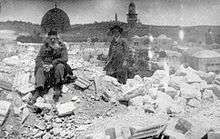
1927 Jericho earthquake: Destruction in the Jewish Quarter of Jerusalem
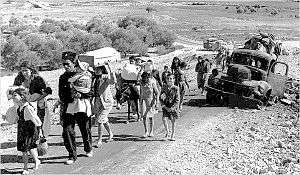
Palestinian Arab refugees in 1948
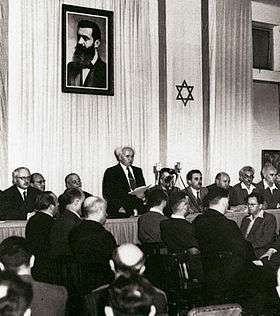
1948: declaration of the establishment of the State of Israel

1993: Bill Clinton , Yitzhak Rabin and Yasser Arafat after signing the Oslo Accords
- 1901 – The Jewish National Fund was founded at the Fifth Zionist Congress in Basel with the aim of buying and developing land in the southern region of Ottoman Syria for Jewish settlement.
- 11 April 1909 – Tel Aviv was founded on the outskirts of the ancient port city of Jaffa.
- 26 January to 4 February 1915 – German led Ottoman Army advanced from Southern Palestine, conducted a Raid on the Suez Canal in an attempt to stop traffic through the canal.
- March–October 1915 – The 1915 locust plague breaks out in the Eastern Mediterranean coastal region.
- 1916–1918 – The Arab Revolt
- 16 May 1916 – Britain and France conclude the secret Sykes-Picot Agreement, which defines their respective spheres of influence and control in Western Asia after the expected demise of the Ottoman Empire at the end of World War I. It was largely a trade agreement with a large area set aside for indirect control through an Arab state or a confederation of Arab states.
- 3–5 August 1916 – German led Ottoman Army attack British Empire forces defending the Suez Canal at the Battle of Romani.
- 23 December 1916 – Anzac Mounted Division occupy El Arish and capture Ottoman garrison during the Battle of Magdhaba.
- 9 January 1917 – Sinai and Palestine Campaign: Battle of Rafa - British Empire forces defeat the Ottoman Empire garrison at Rafah after re-capturing the Egyptian Sinai Peninsula by the Egyptian Expeditionary Force.
- 26 March 1917 – Sinai and Palestine Campaign: First Battle of Gaza - British attack strong Ottoman defences at Gaza, failed after 17,000 German led Ottoman troops block their advance in the Southern Coastal Plain.
- 6 April 1917 – Sinai and Palestine Campaign: The Tel Aviv and Jaffa deportation - The Ottoman authorities deport the entire civilian population of Jaffa and Tel Aviv pursuant to the order from Ahmed Jamal Pasha, the military governor of Ottoman Syria during the First World War. Although the Muslim evacuees are allowed to return before long, the Jewish evacuees were not able to return until after the British conquest of Palestine.[33]
- 19 April 1917 – Sinai and Palestine Campaign: Second Battle of Gaza - Ottoman defenders repels the second British assault on Gaza
- 31 October 1917 – Sinai and Palestine Campaign: Battle of Beersheba - XX Corps infantry and Desert Mounted Corps mounted infantry attack and capture Beersheba on the Gaza to Beersheba defensive line on the northern edge of the Negev Desert, from the Ottoman Empire.
- 31 October-7 November 1917 – Sinai and Palestine Campaign: Third Battle of Gaza - British forces capture Gaza.
- 2 November 1917 – The Balfour Declaration is published in which the British Government declares its support for the establishment of a Jewish national home in what is to become Mandate Palestine.
- 15 November 1917 – Sinai and Palestine Campaign: Australian and New Zealand troops capture Jaffa after the Battle of Mughar Ridge fought on 13 November.
- 17 November-30 December 26, 1917 – Sinai and Palestine Campaign: Battle of Jerusalem - The Ottoman Empire are defeated by the British Empire forces at the Battle of Jerusalem. The British Army's General Allenby enters Jerusalem on foot, in a reference to the entrance of Caliph Umar in 637.
- 21 February 1918 – Sinai and Palestine Campaign: Capture of Jericho – begins Egyptian Expeditionary Force Occupation of the Jordan Valley
- 8–12 March 1918– Sinai and Palestine Campaign: Battle of Tell 'Asur – series of attacks along the Jaffa to Jerusalem line which pushed the front line a few miles north.
- 21 March–2 April 1918 – Sinai and Palestine Campaign: First Transjordan attack on Amman including the First Battle of Amman – an infantry and a mounted division invaded Ottoman Empire territory only to be forced by superior Ottoman forces to retreat back to the Jordan Valley.
- 30 April–4 May 1918 – Sinai and Palestine Campaign: Second Transjordan attack on Shunet Nimrin and Es Salt – second attempt to capture Ottoman Empire territory east of the Jordan River when three divisions were again forced back to the Jordan Valley by superior Ottoman defenders.
- June 1918 – First meeting between the Zionist leader Chaim Weizmann and the son of the Sharif of Mecca Hashemite Prince Faisal, who led the Arab forces in the Arab Revolt against the Ottoman Empire during the First World War, which takes place in Faisal's headquarters in Aqaba in an attempt to establish favourable relations between Arabs and Jews in the Middle East.
- 14 July 1918 – Sinai and Palestine Campaign: Battle of Abu Tellul
- 19–25 September – Sinai and Palestine Campaign: Battle of Megiddo including the Battle of Sharon, the Battle of Nablus and the Third Transjordan attack the Egyptian Expeditionary Force attacked and captured large numbers of Ottoman and German soldiers and Ottoman territory. These battles included the capture of Amman, Arara, Capture of Afulah and Beisan, Haifa, Jenin, Nablus, Samakh, Tabsor, Tiberias Tulkarm, including a series of air raids in the Judean Hills when bombs were dropped on retreating German and Ottoman columns.
- 26 September–1 October 1918 – Sinai and Palestine Campaign: Capture of Damascus – continuing the Egyptian Expeditionary Force attacks and captures of almost two Ottoman armies and territory extending into Syria. During this advance Irbid, Jisr Benat Yakub, Kaukab, and Kiswe were captured. The British Empire offensive continued into Syria with the Charge at Khan Ayash and the Pursuit to Haritan including the Battle of Aleppo to end with the Charge at Haritan on 26 October.
- 30 October 1918 – Sinai and Palestine Campaign: The British Sinai and Palestine Campaign officially ends with the signing of the Armistice of Mudros and, shortly thereafter, the Ottoman Empire is dissolved.
- 11 July 1927 – 1927 Jericho earthquake - A powerful earthquake occurs in the Jordan Rift Valley region.
- 1929 – the outbreak of the 1929 Palestine riots.
- 1936–1939 – The Great Arab Revolt.
- 29 November 1947 – UN General Assembly proposes to divide Mandate Palestine into an Arab and Jewish state.
- 14 May 1948 – Israeli Declaration of Independence: the Jewish leadership in the region of Palestine announces the establishment of the independent and sovereign State of Israel.
- 14 May 1948 – 7 January 1949 – The 1948 Arab-Israeli War: a large-scale war between Israel and five Arab countries and the Palestinian-Arabs. The war resulted in an Israeli victory, with Israel annexing territory beyond the borders of the proposed Jewish state and into the borders of the proposed Arab state and West Jerusalem.[34] Jordan, Syria, Lebanon, and Egypt signed the 1949 Armistice Agreements with Israel. The Gaza Strip and the West Bank, were occupied by Egypt and Transjordan, respectively until 1967. In 1951, the UN Conciliation Commission for Palestine estimated that some 711,000 Palestinian refugees were displaced by the war.[35]
- 29 October 1956 – 5 November 1956 – The Sinai Campaign was held. This war, followed Egypt's decision of 26 July 1956 to nationalize the Suez Canal. The war was initiated by United Kingdom and France, and conducted in cooperation with Israel, aimed at occupying the Sinai Peninsula, with the Europeans regaining control over the Suez Canal. Although the Israeli occupation of the Sinai was successful, the US and USSR forced it to abandon this conquest. However, Israel managed to re-open the Straits of Tiran and secured its southern border.
- 5–10 June 1967 – The Six-Day War took place and was fought between Israel and all of its neighboring countries: Egypt, Jordan, Syria and Lebanon, which were aided by other Arab countries. The war lasted six days and concluded with Israel expanding its territory significantly – Gaza Strip and Sinai from Egypt, the West Bank and Jerusalem from Jordan and the Golan Heights from Syria.
- 6–24 October 1973 – The Yom Kippur War was fought. The war began with a surprise joint attack on two fronts by the armies of Syria (in the Golan Heights) and Egypt (in the Suez Canal), deliberately initiated during the Jewish holiday of Yom Kippur. The Egyptian Army got back Sinai that was occupied by the Israeli armies for almost 7 years.
- 1974 – The PLO is allowed to represent the Palestinian Arab refugees in the UN as their sole political representative organisation.
- 18 September 1978 – Israel and Egypt sign a comprehensive peace agreement at Camp David which included a condition of Israel's withdrawal from the Rest of Sinai.
- 26 March 1979 – The peace treaty with Egypt was signed by the Israeli Prime Minister Menachem Begin, the Egyptian President Anwar Sadat and U.S. President Jimmy Carter.
- June–December 1982 – The First Lebanon War took place during which Israel invaded southern Lebanon due to the constant terror attacks on northern Israel by the Palestinian guerrilla organizations resident there. The war resulted in the expulsion of the PLO from Lebanon, and created an Israeli Security Zone in southern Lebanon.
- 21 November 1984-January 5, 1985 – Operation Moses: IDF forces conduct a secret operation in which approximately 8,000 Ethiopian Jews were brought to Israel from Sudan.
- 15 November 1988-Palestinian Declaration of Independence (1988) - The Palestinian National Council, the legislative body of the Palestinian Liberation Organization (PLO), in Algiers on 15 November 1988 unilaterally proclaimed the establishment of a new independent state called the "State of Palestine".
- 1987–1991 – The First Intifada: The first Palestinian uprising took place in the Gaza Strip and the West Bank against the Israeli occupation of the Palestinian territories.
- 24–25 May 1991 – Operation Solomon: IDF forces conduct a secret operation in which approximately 14,400 Ethiopian Jews were brought to Israel within 34 hours in 30 IAF and El Al aircraft.
- 13 September 1993 – The first Oslo Accords are signed at an official ceremony in Washington in the presence of Yitzhak Rabin for Israel, Yasser Arafat for PLO and Bill Clinton for the United States.
- October 26, 1994 – The Peace agreement between Israel and Jordan is signed.
- 4 November 1995 – Israeli Prime Minister Yitzhak Rabin was assassinated by right-wing Israeli radical Yigal Amir.
- 2000–2005 (unclear) – The Second Intifada: The second Palestinian uprising took place in the Gaza Strip and the West Bank against the Israeli occupation of the Palestinian Territories. The uprising which began as massive protests carried out by Palestinians in the Palestinian Territories, soon turned into a violent Palestinian guerrilla campaign which included numerous suicide attacks carried out against Israeli civilians within the state of Israel.
3rd millennium
21st century
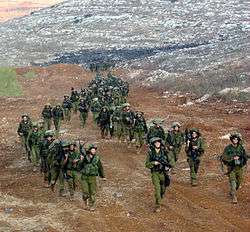
Summer 2006: The Second Lebanon War (photograph taken on August 15, 2006)
- June 2002 – As a result of the significant increase of suicide bombing attacks within Israeli population centers during the first years of the Second Intifada, Israel began the construction of the West Bank Fence along the Green Line border arguing that the barrier is necessary to protect Israeli civilians from Palestinian militants. The significantly reduced number of incidents of suicide bombings from 2002 to 2005 has been partly attributed to the barrier.[36] The barrier's construction, which has been highly controversial, became a major issue of contention between the two sides.
- 23 August 2005 – Israel's unilateral disengagement plan: The evacuation of 25 Jewish settlements in the Gaza Strip and West Bank is completed.
- 12 July – 14 August 2006 – The Second Lebanon War took place, which began as a military operation in response to the abduction of two Israeli reserve soldiers by the Hezbollah, and gradually grew to a wider conflict. 1,191 Lebanese were killed, 4,409 were injured.
- 27 December 2008 – 18 January 2009 – Operation Cast Lead: IDF forces conducted a large-scale military operation in the Gaza Strip during which dozens of targets were attacked in the Gaza Strip in response to ongoing rocket fire on the western Negev. 1,291 Palestinians were killed.
- 14 November 2012 – 21 November 2012 – Operation Pillar of Cloud: IDF forces launches a large-scale military operation in the Gaza Strip in response to Palestinian militants firing over a hundred rockets from the Gaza Strip into southern Israel beginning on 10 November, with the aims of restoring quiet to southern Israel and to strike at what it considers terror organizations.[37] The operation officially began with the assassination of Ahmed Jabari, chief of the Gaza military wing of Hamas.[38] 158 Palestinians were killed.
- 29 November 2012 – United Nations General Assembly resolution 67/19: Upgrading of Palestine to non-member observer state status in the United Nations.[39]
See also
- Palestine (region)
- Land of Israel
- Time periods in the Palestine region
- Timeline of Middle Eastern history
References
- ↑ Vertebrates - dinosaurs – University of Copenhagen
- ↑ Discovery Online, Discovery News Brief
- ↑ Qesem Cave Project - Introduction
- 1 2 3 The Historical Context of the Hebrew Bible and New Testament
- ↑ Historic Battles presented by the South Hill Brass
- ↑ Oxford University Press: 100 Decisive Battles: Paul K. Davis
- 1 2 3 4 IRONI
- ↑ Shiloh (ancient city, Palestine) - Britannica Online Encyclopedia
- ↑ Slavik, Diane. 2001. Cities through Time: Daily Life in Ancient and Modern Jerusalem. Geneva, Illinois: Runestone Press, p. 60. ISBN 978-0-8225-3218-7
- ↑ Edwin Thiele, The Mysterious Numbers of the Hebrew Kings, (1st ed.; New York: Macmillan, 1951; 2d ed.; Grand Rapids: Eerdmans, 1965; 3rd ed.; Grand Rapids: Zondervan/Kregel, 1983). ISBN 0-8254-3825-X, 9780825438257
- ↑
- 960 BCE http://www.bible- history.com/sketches/ancient/tomb-david.html *c.962 BCE http://www.britannica.com/biography/David *970 BCE http://judeochristianchurch.com/did-yeshua-die-exactly-1000-years-after-king-david-died/
- ↑ Joseph P. Free, Howard F. Vos. 1992. Archaeology and Bible history. p. 150. ISBN 978-0-310-47961-1
- ↑ Chronology of the Israelite Tribes from The History Files (historyfiles.co.uk)
- ↑ Greetham, The Rev. Phil. "King Herod the Great." "The Nativity Pages". Archived from the original on 2012-07-23., 2001.
- ↑ Sebaste, Holy Land Atlas Travel and Tourism Agency.
- ↑ Votruba, G., 2007, Imported building materials of Sebastos Harbour, Israel, International Journal of Nautical Archaeology 36: 325-335.
- ↑ "Entry for Herod." The Jewish Virtual Library, American-Jewish Cooperative Enterprise, 2007. Retrieved June 18, 2007.
- ↑ Temple of Herod, Jewish Encyclopedia
- ↑ Timothy David Barnes, “The Date of Herod’s Death,” Journal of Theological Studies ns 19 (1968), 204-19; P. M. Bernegger, “Affirmation of Herod’s Death in 4 B.C.,” Journal of Theological Studies ns 34 (1983), 526-31.
- ↑ Rahner (page 731) states that the consensus among historians is c. 4 BC. Sanders supports c. 4 BC. Vermes supports c. 6/5 BC. Finegan supports c. 3/2 BC. Sanders refers to the general consensus, Vermes a common 'early' date, Finegan defends comprehensively the date according to early Christian traditions.
- ↑ H.H. Ben-Sasson, A History of the Jewish People, Harvard University Press, 1976, ISBN 0-674-39731-2, page 246: "When Archelaus was deposed from the ethnarchy in 6 CE, Judea proper, Samaria and Idumea were converted into a Roman province under the name Iudaea."
- ↑ Ammianus Marcellinus, Res Gestae, 23.1.2–3.
- ↑ Ostrogorsky, George. 1969. History of the Byzantine State. New Brunswick, New Jersey: Rutgers University Press, p. 104. ISBN 0-8135-0599-2
- ↑ Sheila Blair, "What is the date of the Dome of the Rock?", Julian Raby & Jeremy Johns (editors), Bayt Al-Maqdis, Oxsford University Press, 1992
- ↑ Barkat, Amiram (August 8, 2003). "The big one is coming". Haaretz. Retrieved May 11, 2011.
- ↑ Siegel-Itzkovich, Judy (October 14, 2007). "749 CE Golan quake shows another is overdue". The Jerusalem Post. Retrieved May 11, 2011.
- ↑ Abu-Husayn, Abdul-Rahim (2004). The view from Istanbul: Lebanon and the Druze Emirate in the Ottoman chancery documents, 1546-1711. I.B.Tauris. pp. 22–23. ISBN 978-1-86064-856-4.
- ↑ Barnai, Jacob. The Jews in Palestine in the Eighteenth Century: under the patronage of the Istanbul Committee of Officials for Palestine (University of Alabama Press 1992) ISBN 978-0-8173-0572-7; p. 14
- ↑ Joel Rappel. History of Eretz Israel from Prehistory up to 1882 (1980), Vol.2, p.531. "In 1662 Sabbathai Sevi arrived to Jerusalem. It was the time when the Jewish settlements of Galilee were destroyed by the Druze: Tiberias was completely desolate and only a few of former Safed residents had returned..."
- ↑ Gershom Gerhard Scholem (1976-01-01). Sabbatai Sevi: the Mystical Messiah, 1626-1676. Princeton University Press. p. 368. ISBN 978-0-691-01809-6.
In Safed, too, the [Sabbatai] movement gathered strength during the autumn of 1665. The reports about the utter destruction, in 1662 [sic], of the Jewish settlement there seem greatly exaggerated, and the conclusions based on them are false. ... Rosanes' account of the destruction of the Safed community is based on a misunderstanding of his sources; the community declined in numbers but continued to exist ... A very lively account of the Jewish community is given by French trader d'Arvieux who visited Safed in 1660.
- ↑ Sbeinati, M.R., Darawcheh, R. & Mouty, M. 2005. The historical earthquakes of Syria: an analysis of large and moderate earthquakes from 1365 B.C. to 1900 A.D. Annals of Geophysics, 48, 347-435.
- ↑ Mishkenot Sha'ananim
- ↑ Friedman, Isaiah (1971). German Intervention on Behalf of the "Yishuv", 1917 , Jewish Social Studies, Vol. 33, pp. 23–43.
- ↑ Baylis Thomas (1999) How Israel was won: a concise history of the Arab-Israeli conflict Lexington Books, ISBN 0-7391-0064-5 p xiv
- ↑ General Progress Report and Supplementary Report of the United Nations Conciliation Commission for Palestine, Covering the Period from 11 December 1949 to 23 October 1950, published by the United Nations Conciliation Commission, 23 October 1950. (U.N. General Assembly Official Records, 5th Session, Supplement No. 18, Document A/1367/Rev. 1: Retrieved 5 January 2015)]
- ↑ Nissenbaum, Dion (January 10, 2007). "Death toll of Israeli civilians killed by Palestinians hit a low in 3015". Washington Bureau. McClatchy Newspapers. Retrieved April 16, 2007.
Fewer Israeli civilians died in Palestinian attacks in 2006 than in any year since the Palestinian uprising began in 2000. Palestinian militants killed 23 Israelis and foreign visitors in 2006, down from a high of 289 in 2002 during the height of the uprising. Most significant, successful suicide bombings in Israel nearly came to a halt. Last year, only two Palestinian suicide bombers managed to sneak into Israel for attacks that killed 11 people and wounded 30 others. Israel has gone nearly nine months without a suicide bombing inside its borders, the longest period without such an attack since 2000[...] An Israeli military spokeswoman said one major factor in that success had been Israel's controversial separation barrier, a still-growing 250-mile (400 km) network of concrete walls, high-tech fencing and other obstacles that cuts through parts of the West Bank. ‘The security fence was put up to stop terror, and that's what it's doing,’ said Capt. Noa Meir, a spokeswoman for the Israel Defense Forces. [...] Opponents of the wall grudgingly acknowledge that it's been effective in stopping bombers, though they complain that its route should have followed the border between Israel and the Palestinian territories known as the Green Line. [...] IDF spokeswoman Meir said Israeli military operations that disrupted militants planning attacks from the West Bank also deserved credit for the drop in Israeli fatalities.
- ↑
- ↑
- ↑ Resolution adopted by the General Assembly on 29 November 2012: without reference to a Main Committee (A/67/L.28 and Add.1): 67/19. Status of Palestine in the United Nations
Further reading
- Philip Mattar (2005). "Chronology". Encyclopedia of the Palestinians. Facts on File. ISBN 978-0-8160-6986-6.
This article is issued from Wikipedia - version of the 11/7/2016. The text is available under the Creative Commons Attribution/Share Alike but additional terms may apply for the media files.

